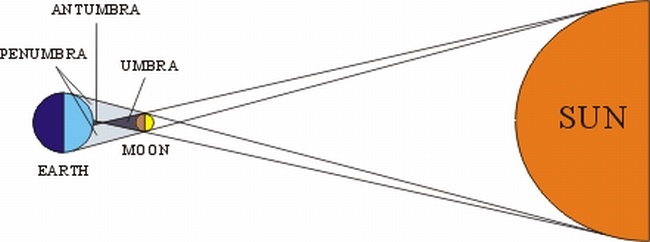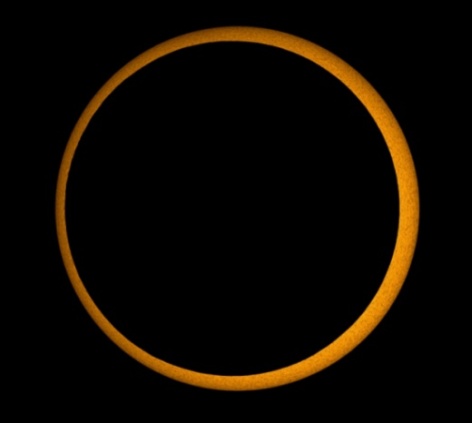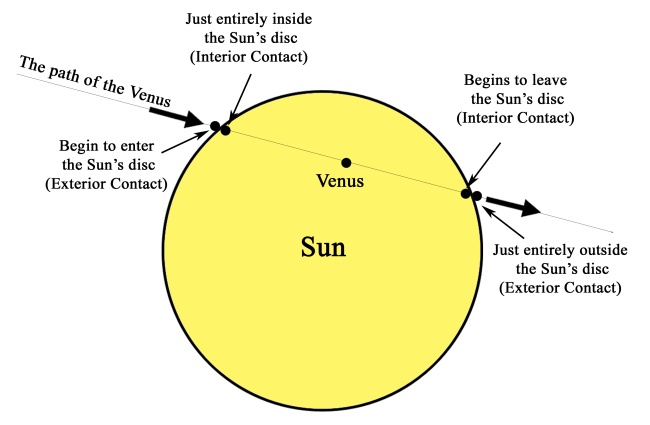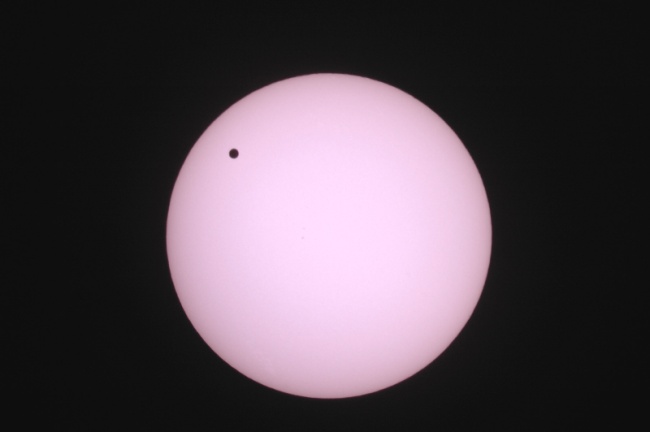Don't miss the two forthcoming astronomical events
18 May 2012
Solar eclipse occurs when the Moon comes between the Earth and the Sun, blocking parts or all of the Sun's rays from reaching the Earth's surface. This phenomenon can be observed at places under the shadow of the Moon on Earth (See Figure 1). Ancient Chinese described solar eclipse as "Tiangou eating the Sun", because the Sun looked like being eaten by Tiangou - a mythical creature that literally means a dog in the sky.
As the Moon's orbit around the Earth is elliptical, the distance between the Moon and the Earth will vary with time. In case the eclipse occurs when the Moon is far from the Earth, the Moon cannot fully obscure the whole disc of the Sun, resulting in a very bright ring surrounding the silhouette of the Moon. Such an eclipse is known as annular solar eclipse. (See Figure 2).
Annular solar eclipses are very rare astronomical phenomena. Although there are on average two to three solar eclipses every year globally, observing an annular or total eclipse at your place of residence is an invaluable experience as the shadow of the Moon on Earth is relatively small and the majority part of the Earth, such as oceans and glaciers, is uninhabited. Although there were 71 annular solar eclipses and 68 total solar eclipses in the 20th Century, only one annular solar eclipse was observable in Hong Kong commencing at 10:53 am on 19 April 1958. The duration of annular totality (from totality begins to totality ends) of that eclipse only lasted for 1 minute 17 seconds. After more than half a century, there is another chance for us in Hong Kong to enjoy this rare astronomical phenomenon at sunrise on 21 May 2012. If we miss it this time, the next annular solar eclipse to be observable in Hong Kong will have to wait until 2320 !
As most parts of the Sun's disc is obscured during an annular solar eclipse, solar radiation and surface temperatures would normally fall slightly. However, these effects for the 21 May event will be minimal as it will occur just after sunrise, despite over 90% of the Sun's disc will be obscured.
Besides the Moon, eclipses would also be caused by Venus and Mercury. These eclipses, which are more precisely termed as "transit across the Sun" or just "transit", occur when Venus or Mercury passes between the Sun and the Earth.
Although the diameter of Venus is almost four times that of the Moon, due to its much larger distance away from the Earth (See Figures 3 and 4), we can just see a small black spot travelling across the face of the Sun during "Transit of Venus". As just a very small part of the Sun is obscured by the Venus during the transit, the effect on the solar radiation on Earth will be negligible.
"Transit of Venus" is also a rare astronomical phenomenon. In a period of more than 100 years, it only occurs in pairs separated by 8 years. Why is it such a case? It is because 8 years of the Earth in completing its cycle of rotation around the Sun are close to 13 years of the Venus, and hence Venus and Earth will return to nearly the same point in their respective orbits every eight years. Transits of Venus do not occur every 8 years, however, as there is an inclination of 3.4o between the orbital plane of Venus and that of the Earth. It happens that, eight years after the first transit, Venus would return to the ecliptic plane of the Earth. After that it has to take over a hundred years for Venus to meet the ecliptic plane again, when another pair of Transit of Venus is due to occur. The first "Transit of Venus" in the 21st Century occurred on 8 June 2004. Eight years later, Hong Kong and most regions on Earth will have the chance to observe this rare astronomical phenomenon again in the morning on 6 June 2012. The last pair of "Transit of Venus" was in December 1874 and December 1882, while the next pair will occur in 2117 and 2125.
Relatively speaking, "Transit of Mercury" occurs more frequently than "Transit of Venus" due to its shorter cycle of rotation around the Sun. The last "Transit of Mercury" was on 8 November 2006, and the next one to be observable in Hong Kong will occur in 2032.
Astronomical observation is a relaxing and most enjoyable activity. It is nonetheless very important to get well prepared with proper equipment to observe the annular eclipse and "Transit of Venus", such as to use qualified solar filters to protect our eyes or to view the Sun's image projected through a pin-hole onto a piece of cardboard. We should never look directly into the sun with naked eyes to avoid severe damages to our eyes. For more information on the annular solar eclipse and "Transit of Venus" as well as the proper methods to observe the events, please refer to the press release[1] and related web pages of the Hong Kong Observatory[2] [3].
Lastly, whether or not we could catch these two forthcoming rare astronomical events would also depend on the weather at the time ! Let's keep our fingers crossed !
Dickson Lau
References:
[1] Rare annular solar eclipse in Hong Kong on May 21
http://www.weather.gov.hk/press/D4/2012/pre20120507e.htm
[2] About Transit of Venus by the Hong Kong Observatory
http://www.hko.gov.hk/gts/event/event-venus-transit_e.htm
[3] About Solar Eclipse by the Hong Kong Observatory
http://www.hko.gov.hk/gts/event/event-solar-eclps1_e.htm
[4] Press release on "Observations made by Hong Kong Observatory during partial solar eclipse" on 22 July 2009
http://www.hko.gov.hk/press/SP/pre20090722e.htm
[5] About Planetary Transits by NASA
http://eclipse.gsfc.nasa.gov/transit/transit.html

Figure 1Relative positions of the Sun, the Moon and the Earth during an annular solar eclipse

Figure 2Photo of "Annular solar eclipse" taken in India on 15 Jan 2010
Photo courtesy of Mr. Mikael Svalgaad
(http://www.leif.org/mikael/astro_index.html)

Figure 3Path of Transit of Venus

Figure 4Photo of "Transit of Venus" taken at the Hong Kong Observatory on 8 June 2004
As the Moon's orbit around the Earth is elliptical, the distance between the Moon and the Earth will vary with time. In case the eclipse occurs when the Moon is far from the Earth, the Moon cannot fully obscure the whole disc of the Sun, resulting in a very bright ring surrounding the silhouette of the Moon. Such an eclipse is known as annular solar eclipse. (See Figure 2).
Annular solar eclipses are very rare astronomical phenomena. Although there are on average two to three solar eclipses every year globally, observing an annular or total eclipse at your place of residence is an invaluable experience as the shadow of the Moon on Earth is relatively small and the majority part of the Earth, such as oceans and glaciers, is uninhabited. Although there were 71 annular solar eclipses and 68 total solar eclipses in the 20th Century, only one annular solar eclipse was observable in Hong Kong commencing at 10:53 am on 19 April 1958. The duration of annular totality (from totality begins to totality ends) of that eclipse only lasted for 1 minute 17 seconds. After more than half a century, there is another chance for us in Hong Kong to enjoy this rare astronomical phenomenon at sunrise on 21 May 2012. If we miss it this time, the next annular solar eclipse to be observable in Hong Kong will have to wait until 2320 !
As most parts of the Sun's disc is obscured during an annular solar eclipse, solar radiation and surface temperatures would normally fall slightly. However, these effects for the 21 May event will be minimal as it will occur just after sunrise, despite over 90% of the Sun's disc will be obscured.
Besides the Moon, eclipses would also be caused by Venus and Mercury. These eclipses, which are more precisely termed as "transit across the Sun" or just "transit", occur when Venus or Mercury passes between the Sun and the Earth.
Although the diameter of Venus is almost four times that of the Moon, due to its much larger distance away from the Earth (See Figures 3 and 4), we can just see a small black spot travelling across the face of the Sun during "Transit of Venus". As just a very small part of the Sun is obscured by the Venus during the transit, the effect on the solar radiation on Earth will be negligible.
"Transit of Venus" is also a rare astronomical phenomenon. In a period of more than 100 years, it only occurs in pairs separated by 8 years. Why is it such a case? It is because 8 years of the Earth in completing its cycle of rotation around the Sun are close to 13 years of the Venus, and hence Venus and Earth will return to nearly the same point in their respective orbits every eight years. Transits of Venus do not occur every 8 years, however, as there is an inclination of 3.4o between the orbital plane of Venus and that of the Earth. It happens that, eight years after the first transit, Venus would return to the ecliptic plane of the Earth. After that it has to take over a hundred years for Venus to meet the ecliptic plane again, when another pair of Transit of Venus is due to occur. The first "Transit of Venus" in the 21st Century occurred on 8 June 2004. Eight years later, Hong Kong and most regions on Earth will have the chance to observe this rare astronomical phenomenon again in the morning on 6 June 2012. The last pair of "Transit of Venus" was in December 1874 and December 1882, while the next pair will occur in 2117 and 2125.
Relatively speaking, "Transit of Mercury" occurs more frequently than "Transit of Venus" due to its shorter cycle of rotation around the Sun. The last "Transit of Mercury" was on 8 November 2006, and the next one to be observable in Hong Kong will occur in 2032.
Astronomical observation is a relaxing and most enjoyable activity. It is nonetheless very important to get well prepared with proper equipment to observe the annular eclipse and "Transit of Venus", such as to use qualified solar filters to protect our eyes or to view the Sun's image projected through a pin-hole onto a piece of cardboard. We should never look directly into the sun with naked eyes to avoid severe damages to our eyes. For more information on the annular solar eclipse and "Transit of Venus" as well as the proper methods to observe the events, please refer to the press release[1] and related web pages of the Hong Kong Observatory[2] [3].
Lastly, whether or not we could catch these two forthcoming rare astronomical events would also depend on the weather at the time ! Let's keep our fingers crossed !
Dickson Lau
References:
[1] Rare annular solar eclipse in Hong Kong on May 21
http://www.weather.gov.hk/press/D4/2012/pre20120507e.htm
[2] About Transit of Venus by the Hong Kong Observatory
http://www.hko.gov.hk/gts/event/event-venus-transit_e.htm
[3] About Solar Eclipse by the Hong Kong Observatory
http://www.hko.gov.hk/gts/event/event-solar-eclps1_e.htm
[4] Press release on "Observations made by Hong Kong Observatory during partial solar eclipse" on 22 July 2009
http://www.hko.gov.hk/press/SP/pre20090722e.htm
[5] About Planetary Transits by NASA
http://eclipse.gsfc.nasa.gov/transit/transit.html

Figure 1Relative positions of the Sun, the Moon and the Earth during an annular solar eclipse

Figure 2Photo of "Annular solar eclipse" taken in India on 15 Jan 2010
Photo courtesy of Mr. Mikael Svalgaad
(http://www.leif.org/mikael/astro_index.html)

Figure 3Path of Transit of Venus

Figure 4Photo of "Transit of Venus" taken at the Hong Kong Observatory on 8 June 2004